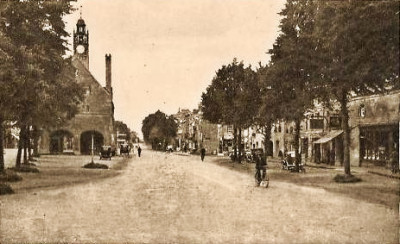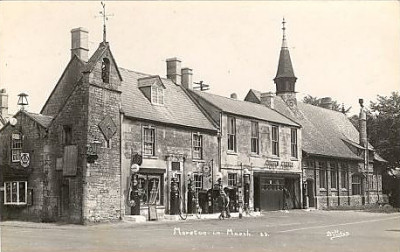
Moreton - North end of High Street 1920s or 30s
The exact origin of the name “Moreton-in-Marsh” is, like that of many other settlements in this part of Britain, obscured by the depths of history. Broadly derived from Old English, “Moreton” means a “farm or settlement on the moor”. The “in-Marsh” suffix is a little more open to debate possibly being a corruption of “Henne and Mersh” – an area of marshy land where game such as Moorhens may be found. Another explanation is that it is a corruption of the word ‘March’, meaning a boundary.
Until changes were made to the County boundaries in the 19th Century the four county boundaries of Gloucestershire, Worcestershire, Oxfordshire and Warwickshire met just to the East of Moreton marked still by the ‘Four shires Stone’.

Approaching the Redesdale Hall
The Fosse Way runs through the heart of Moreton as a wide street , a remnants of one of the most important aspects of Moreton’s origins and history, its place as a market town. Moreton was owned by Westminster Abbey from shortly before the Norman conquest until 1856. Situated on a busy crossroads where the road from Worcester to London crosses the Fosse Way, an Enterprising Abbot of Westminster procured for the town a Charter for a weekly market in 1227. Forty years later the right to hold a town fair was granted but, reading through various histories, I get the feeling that Moreton was never quite the profitable holding the Church hoped it would be as business at the market slowly dwindled.
King Charles the first granted the town another market charter in 1638 and stayed in the town 6 years later. It is not recorded whether the ghost that inhabits the White Hart Hotel where he lodged appeared after the King met his end one frosty morning early in 1649.

The Garage at the Curfew Tower
The two most prominent landmarks in the town are the Redesdale Hall, built in 1887 by Sir Algernon Mitford, first Baron Redesdale and Lord of the Manor of Moreton in Marsh and the Curfew tower built in the early 1630s. The latter is probably one of the oldest building of any significance in Moreton. Most, on the High Street at least, were constructed in the 17th and 18th centuries when the town was flourishing from the business brought by the wool trade and coach travellers staying in the town as they rested while passing through.

A carriage from the Moreton to Stratford Tramway
Moreton’s transportation links were enhanced in the early 19th century with the construction of the Stratford and Moreton Tramway, constructed between 1821 and 1826. This provide a link, albeit horse-drawn, between Moreton and the Stratford-on-Avon canal. The section of the tramway between Moreton and Shipston was converted to run steam locomotives in 1859. In 1853 Moreton’s station on the Oxford, Worcester and Wolverhampton Railway opened, the line being taken over by GWR in 1862. The Shipston branch was taken over a few years later but it was closed to passengers in 1929 and closed completely in 1960.